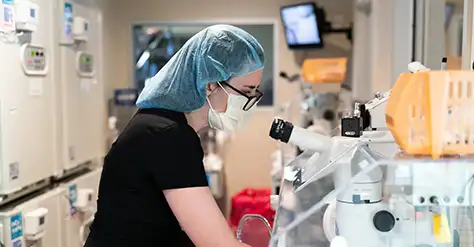Assisted Hatching
Fertility Treatment That Improves Embryo Implantation
Assisted Hatching to Increase IVF Implantation Rates

Assisted hatching is a procedure to help improve embryo implantation. Embryos have a thick outer shell called the zona pellucida. In order for implantation to occur, the embryo must “hatch” or break through the zona pellucida. However, when the zona is too thick, the embryo may have difficulty with the hatching process, preventing the embryo from implantation into the uterus.
How is Assisted Hatching Performed?
Assisted hatching, developed in the 1990s, assists with the implantation of embryos. During the hatching procedure, the zona pellucida is thinned or ruptured. This can be done using an acidic mixture or with a laser. The assisted hatching is performed with micromanipulation, requiring the use of robotic assistance, microscopic tools, and a microscope to view the embryos. As with any procedure, there is a small risk that one or more of the embryo’s cells may be damaged during the procedure. This risk is very small, and it is unlikely to prevent the continued development of the embryo. To reduce the risks of complications after the assisted hatching procedure, your physician may place you on both an antibiotic and a steroid.
Can Assisted Hatching Benefit IVF Patients?
Assisted hatching is thought to be helpful in in-vitro fertilization (IVF) cases in which embryos lack sufficient energy to complete the hatching process on their own, allowing implantation to occur. However, there are no conclusive laboratory controlled test results that support generalized assisted hatching for all patients.
Following the guidelines set forth by the American Society for Reproductive Medicine are very important as assisted hatching is not recommended for every couple going through IVF. According to The American Society for Reproductive Medicine, assisted hatching appears to be most beneficial for women who are over the age of 38, women who have had at least two unsuccessful IVF treatments and poor embryo quality.